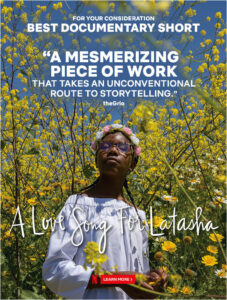Sophia Nahli Allison’s A LOVE SONG FOR LATASHA righteous rebuttal to the  injustice surrounding the shooting death of 15-year-old Latasha Harlins at a South Central Los Angeles store that became a flashpoint for the city’s 1992 civil uprising. As the Black community expressed its profound pain in the streets, Latasha’s friends and family privately mourned the loss of a vibrant child whose full story was never in the headlines. Three decades later, A LOVE SONG FOR LATASHA removes Latasha from the context of her death and rebuilds an archive of a promising life lost. Oral history and memories from Latasha’s best friend and cousin converge in a dreamlike portrait that shows the impact
injustice surrounding the shooting death of 15-year-old Latasha Harlins at a South Central Los Angeles store that became a flashpoint for the city’s 1992 civil uprising. As the Black community expressed its profound pain in the streets, Latasha’s friends and family privately mourned the loss of a vibrant child whose full story was never in the headlines. Three decades later, A LOVE SONG FOR LATASHA removes Latasha from the context of her death and rebuilds an archive of a promising life lost. Oral history and memories from Latasha’s best friend and cousin converge in a dreamlike portrait that shows the impact  one brief but brilliant life can have. Sophia Nahli Allison grew up in South Central Los Angeles and recalls experiencing the 1992 L.A. riots as a four year-old girl. Though Latasha’s death was a catalyst for the riots, Sophia
one brief but brilliant life can have. Sophia Nahli Allison grew up in South Central Los Angeles and recalls experiencing the 1992 L.A. riots as a four year-old girl. Though Latasha’s death was a catalyst for the riots, Sophia  wanted to make a film about Latasha’s life so she would be remembered beyond the trauma of a Black body, beyond a statistic, a newspaper headline, or an inaccurate Wikipedia page. Director, producer, cinematographer and editor Sophia Nahli Allison stops by to talk about how a Latasha’s legacy should not be judged in terms of longevity or her tragic end, but on the lasting impact that Latasha’s kindness, bravery and encouragement continues to have on people’s lives.
wanted to make a film about Latasha’s life so she would be remembered beyond the trauma of a Black body, beyond a statistic, a newspaper headline, or an inaccurate Wikipedia page. Director, producer, cinematographer and editor Sophia Nahli Allison stops by to talk about how a Latasha’s legacy should not be judged in terms of longevity or her tragic end, but on the lasting impact that Latasha’s kindness, bravery and encouragement continues to have on people’s lives.
Download MP3 Podcast | Open Player in New Window
For news and updates go to: alovesongforlatasha.com
Available on netflix.com/Latasha
2021 Oscar® nominee – Best Documentary Short
The Latasha Harlins story continues… Earlier this year, a mural created by artist Victoria Cassinova and dedicated to the life and legacy of Latasha Harlins debuted on what would have been her 45th birthday. Located at the Algin Sutton Recreation Center in South LA, the mural stands at the front of the building where Latasha and her friends spent time throughout their childhood and teenage years. The art is based on a portrait of Latasha meant to represent her innocence and youth. The words to the left of her face are a poem Latasha wrote, it is also spoken in the film. The phrase “We Queens” is something Latasha often said to her friends to remind them of their power and importance. Latasha’s full name is a focal point. Watch a video of the mural’s creation that can be downloaded here.
The Latasha Harlins story continues… Earlier this year, a mural created by artist Victoria Cassinova and dedicated to the life and legacy of Latasha Harlins debuted on what would have been her 45th birthday. Located at the Algin Sutton Recreation Center in South LA, the mural stands at the front of the building where Latasha and her friends spent time throughout their childhood and teenage years. The art is based on a portrait of Latasha meant to represent her innocence and youth. The words to the left of her face are a poem Latasha wrote, it is also spoken in the film. The phrase “We Queens” is something Latasha often said to her friends to remind them of their power and importance. Latasha’s full name is a focal point. Watch a video of the mural’s creation that can be downloaded here.
SOCIAL MEDIA
twitter.com/SophiaNAllison
instagram.com/yagurlsophia
instagram.com/alovesongforlatasha
@SophiaNAllison
“Allison’s experimental style, lush palette, fast-paced editing and tender close-ups on Latasha’s cousins and friends, all now 40-something Black women like me, recreate the loss of Latasha’s innocence.” – The New York Times
“If you’ve seen anything of Latasha’s life, it’s likely the final seconds of her existence. Allison instead creates a brief, stirring portrait of the fifteen years that preceded them.” – Esquire
“The 15-minute film gives new meaning to the notion of “short and sweet” and in it, Allison manages to paint a picture of a life not lived. A Love Song for Latasha is a mesmerizing piece of work that takes an unconventional route to storytelling.” – The Grio
“This documentary is an invitation to rethink how Black life and death are documented in a society where the media glamorizes violence against Black bodies. This work is especially crucial during these a time when Black death is at the forefront of daily coverage, and it challenges us to remember the Black womxn, trans men, and non-binary folx we’ve lost and to reimagine the rich and nuanced lives they lived.” – Vice
